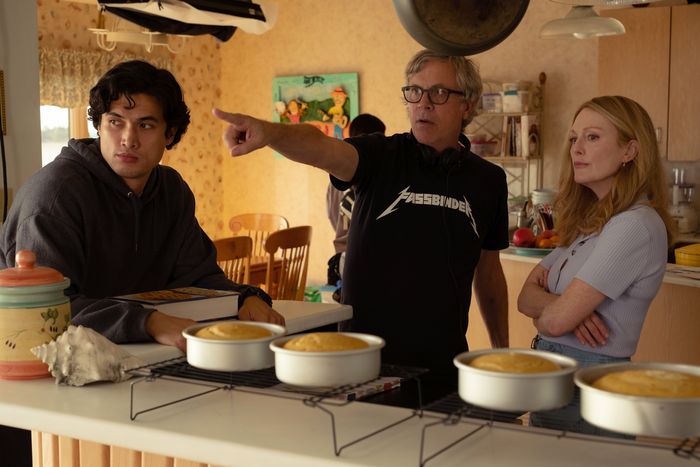
Photo: Courtesy of Netflix
There are many standout moments in May December, the latest cinematic achievement from director Todd Haynes: a haunting performance from Charles Melton; Natalie Portman really getting into character by plugging herself into a nebulizer; Julianne Moore’s deadpan delivery of the line, “I don’t think we have enough hot dogs.” For nearly two hours, I could not take my eyes off of Portman and Moore having the bitchiest “mother off” I’ve seen on screen all year while a bleary-eyed, dad-bodded Melton gingerly played with butterflies. But when I left the theater, I couldn’t stop thinking about those pineapple upside-down cakes.
In the film, Moore plays Gracie Atherton-Yoo, a Georgia housewife who compulsively bakes and sells pineapple upside-down cakes to her neighbors on a weekly basis. The sad thing is, they only keep buying them from her out of pity because Gracie is a pariah, on account of having become the subject of a tabloid sex scandal in the 90s when she started an affair with her 13-year-old coworker at the local pet store (yikes). We meet her in the kitchen several years later, a registered sex offender living a quiet life with Joe (Melton), now her husband, and their teenage twins (yikes again).
May December is inspired by the true story of Mary Kay Letourneau and her sixth-grade paramour-turned-husband (and father of two of her children) Vili Fualaau, but Haynes takes a meta approach to this version of the story by tossing Elizabeth (played by Portman, based on no one in particular) into the mix. A celebrated actress hired to play Gracie in an indie movie based on her life, Elizabeth is determined to get it right. Gracie allows her into her home to observe her, naturally so that the character study can be as accurate as possible. In one intimate kitchen scene, she teaches Elizabeth how to make her “famous” pineapple upside-down cakes. God, I love melodrama!
Charles Melton, Todd Haynes, Julianne Moore, and the pineapple upside-down cakes in question.
Photo: François Duhamel / Courtesy of Netflix
Netflix, which distributed May December in theaters and is now hosting the film on their platform as of December 1, was gracious enough to share the recipe used in the film when I inquired about it. It’s easy enough to follow, with just a handful of steps and simple ingredients. And because I love all of my coworkers equally (except for the ones who refused to try my cake, obviously), I brought my version of this dessert into the office this week for everyone to sample.
Here’s how to do it: To start, you must preheat the oven to 350 degrees. Then, combine one and a half cups of flour, two teaspoons baking powder, and a quarter teaspoon salt in a large bowl. In another bowl, and with an electric mixer (I do not have an electric mixer because I am a fake housewife so I used a spoon and my clean hands), cream six tablespoons of room temperature butter and a whole cup of sugar together until the mixture is light and fluffy. Add two eggs and a teaspoon of vanilla extract into that same bowl, and beat everything together until combined.
This next step I almost messed up, but it’s actually not as complicated as it sounds. The recipe calls for you to “add flour mixture in three additions alternately with the milk in two, beginning and ending with the flour.” What that means is, stir a third of the flour mixture into your bowl with the eggs, then stir in half of the milk, then add in another third of the flour and stir, followed by the remaining half of the milk, and then the final third of the flour mixture.
This next part of the recipe requires the use of a cast iron skillet, which I do not have because I gave mine away to my former roommate when I moved out a few years ago (if you’re reading this, I promise I am not being shady and I do not want it back!). If you do have a cast iron skillet, you’re supposed to combine two-thirds of a cup of sugar and two tablespoons of butter in the skillet over low heat and stir until the mixture becomes a light caramel color. If you’re like me and don’t have one, just do that in a skillet and pour it into a heavily buttered nine-inch round cake pan. (Apologies for all of the butter, but everything is going to stick to the pan if you don’t do this).
Gently arrange pineapple slices in the skillet or pan (I used a can of round pineapple slices in juice, not the kind that uses syrup, because that just felt like it would be too much). While spooning the batter over the sliced pineapples I remembered Gracie’s sibilant suggestion to Elizabeth: “You do it nicely, ‘cause it really does matter how it looks.” Fair enough, Gracie! Place the cake in the oven for 45 minutes (mine was done after about 40 minutes, when a toothpick inserted in the middle came out clean). Let it cool for five minutes, run a knife around the edges of the pan (or skillet) and carefully invert the cake onto a platter.


From left: This is what my cake looked like when it was fresh out of the oven. I’m being very vulnerable by sharing this so please do not drag me – I clearly have a penchant for melodramatics. Photo: Brooke MarineI had to put it back in the pan to transport it to the office. I also had to taste it to make sure it was edible before potentially ruining a coworker’s life. Again, please do not drag me. Photo: Brooke Marine
From top: This is what my cake looked like when it was fresh out of the oven. I’m being very vulnerable by sharing this so please do not drag me – I c…
From top: This is what my cake looked like when it was fresh out of the oven. I’m being very vulnerable by sharing this so please do not drag me – I clearly have a penchant for melodramatics. Photo: Brooke MarineI had to put it back in the pan to transport it to the office. I also had to taste it to make sure it was edible before potentially ruining a coworker’s life. Again, please do not drag me. Photo: Brooke Marine
So, how did it look? I am of the opinion that my cake appeared to be appetizing. My colleagues agreed, except for one hater who announced in front of an entire conference room of Cut staffers that it looked gross (I’m choosing to believe she was just playing the part of a judgmental townsperson, just like in the film). Everyone else used phrases like “moist,” “a perfectly fine snacking cake,” “spongy,” “nice crumb,” and “just sweet enough” to describe the taste. But who knows, maybe they were taking pity on me too.
While sampling my attempt, it occurred to me that I’d never had pineapple upside-down cake before, so I have no frame of reference for how it is actually supposed to taste. And I know you’re probably thinking, Wait a minute, where are the cherries???, but the recipe Netflix shared with me did not call for maraschino cherries! Sorry to the production designer who created the recipe for the film, but I wish it did include that ingredient because it would’ve added a sweeter dimension to the cake (not that it really needs that much more sugar). Anyway, I’m clearly not a recipe writer. All I know is that pineapple upside-down cake is a retro dessert popularized in the 1920s and I have to imagine that if I ate one of these every week like they do in the Atherton-Yoo household I would probably need to see a doctor. Bon appétit!
Source link













